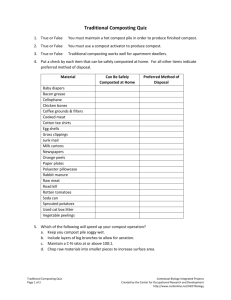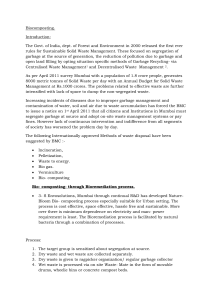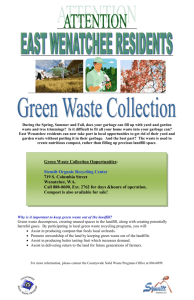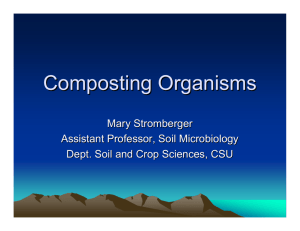Answer Key for Traditional Composting Quiz
advertisement
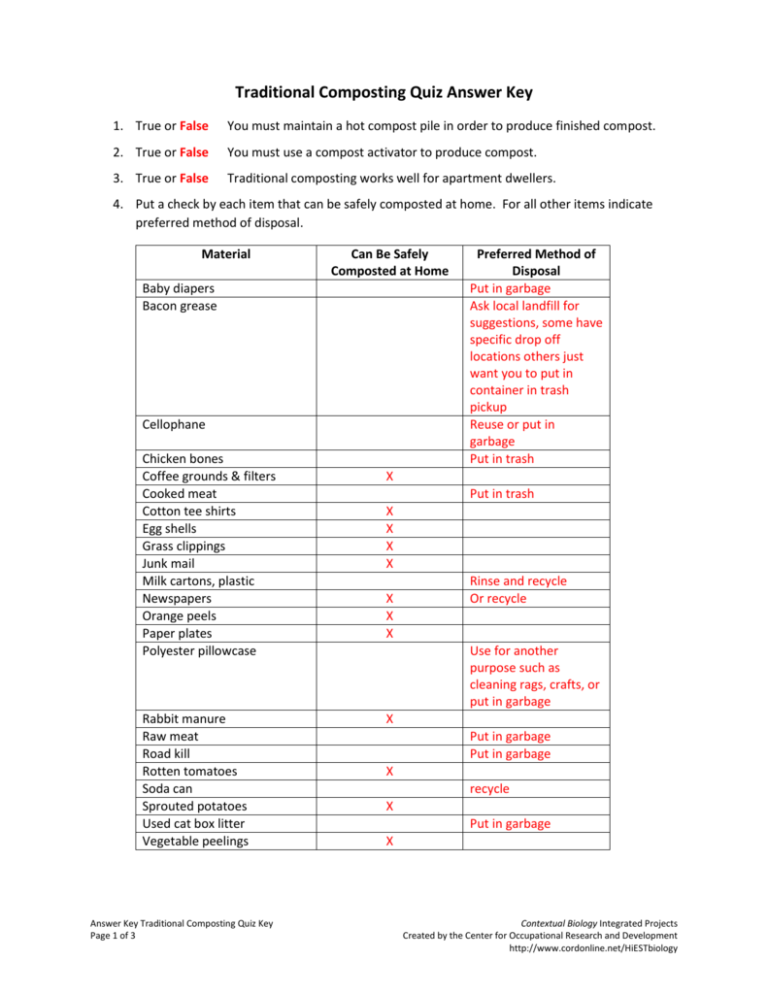
Traditional Composting Quiz Answer Key 1. True or False You must maintain a hot compost pile in order to produce finished compost. 2. True or False You must use a compost activator to produce compost. 3. True or False Traditional composting works well for apartment dwellers. 4. Put a check by each item that can be safely composted at home. For all other items indicate preferred method of disposal. Material Can Be Safely Composted at Home Baby diapers Bacon grease Cellophane Chicken bones Coffee grounds & filters Cooked meat Cotton tee shirts Egg shells Grass clippings Junk mail Milk cartons, plastic Newspapers Orange peels Paper plates Polyester pillowcase Rabbit manure Raw meat Road kill Rotten tomatoes Soda can Sprouted potatoes Used cat box litter Vegetable peelings Answer Key Traditional Composting Quiz Key Page 1 of 3 Preferred Method of Disposal Put in garbage Ask local landfill for suggestions, some have specific drop off locations others just want you to put in container in trash pickup Reuse or put in garbage Put in trash X Put in trash X X X X X X X Rinse and recycle Or recycle Use for another purpose such as cleaning rags, crafts, or put in garbage X Put in garbage Put in garbage X recycle X Put in garbage X Contextual Biology Integrated Projects Created by the Center for Occupational Research and Development http://www.cordonline.net/HiESTbiology 5. Which of the following will speed up your compost operation? a. Keep you compost pile soggy wet. b. Include layers of big branches to allow for aeration. c. Maintain a C-N ratio at or above 100:1. d. Chop raw materials into smaller pieces to increase surface area. 6. These bacteria work best in temperatures around 55°F. a. Mesophiic b. Thermophilic c. Anaerobic d. Aerobic e. Psycrohpilic 7. These bacteria work best in environments with oxygen. a. Mesophiic b. Thermophilic c. Anaerobic d. Aerobic e. Psycrohpilic 8. These bacteria start working when your compost pile heats up over 100°F. a. Mesophiic b. Thermophilic c. Anaerobic d. Aerobic e. Psycrohpilic 9. The byproducts produced when these bacteria break down wastes include hydrogen sulfide and other smelly compounds. a. Mesophiic b. Thermophilic c. Anaerobic d. Aerobic e. Psycrohpilic 10. These bacteria would predominate in room temperature environments. a. Mesophiic b. Thermophilic c. Anaerobic d. Aerobic e. Psycrohpilic 11. Describe the uses and benefits of compost and composting. Use back of sheet if needed. Accept any reasonable answer such as: Composting keeps organic materials out of the landfill. Compost can be used as a soil amendment to improve soil structure, porosity, and density, thus creating a better plant root environment. It improves water holding capacity in sandy soils, it supplies a Answer Key Traditional Composting Quiz Key Page 2 of 3 Contextual Biology Integrated Projects Created by the Center for Occupational Research and Development http://www.cordonline.net/HiESTbiology variety of nutrients to plants, and it improves and stabilizes soil pH. Note: Student answers will depend on the research that they did. Answer Key Traditional Composting Quiz Key Page 3 of 3 Contextual Biology Integrated Projects Created by the Center for Occupational Research and Development http://www.cordonline.net/HiESTbiology
